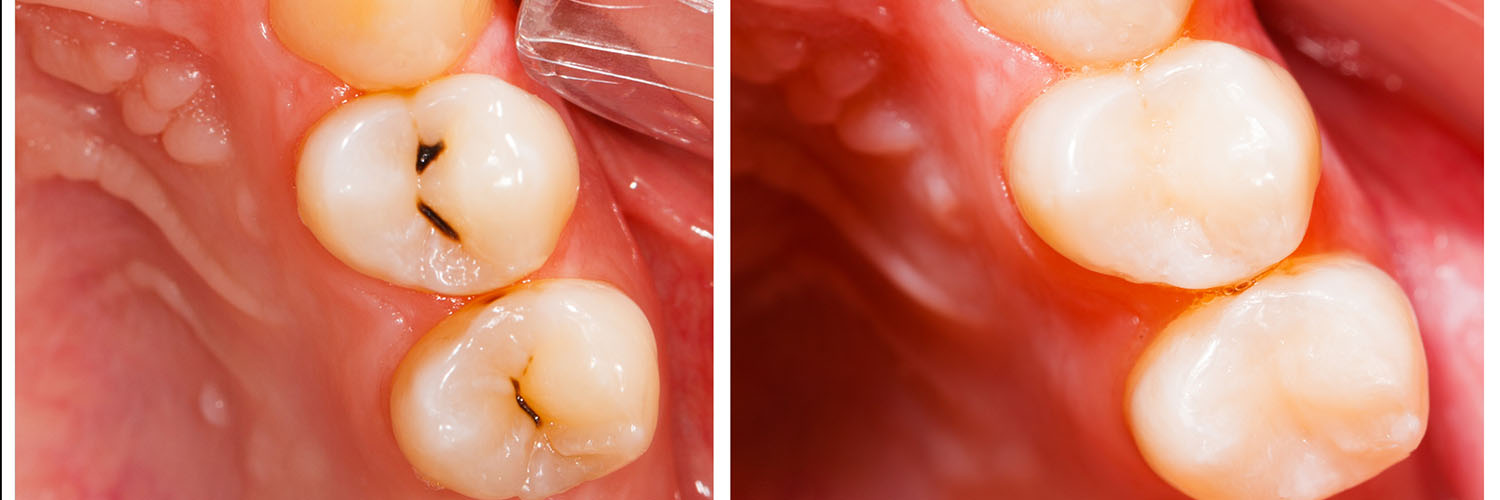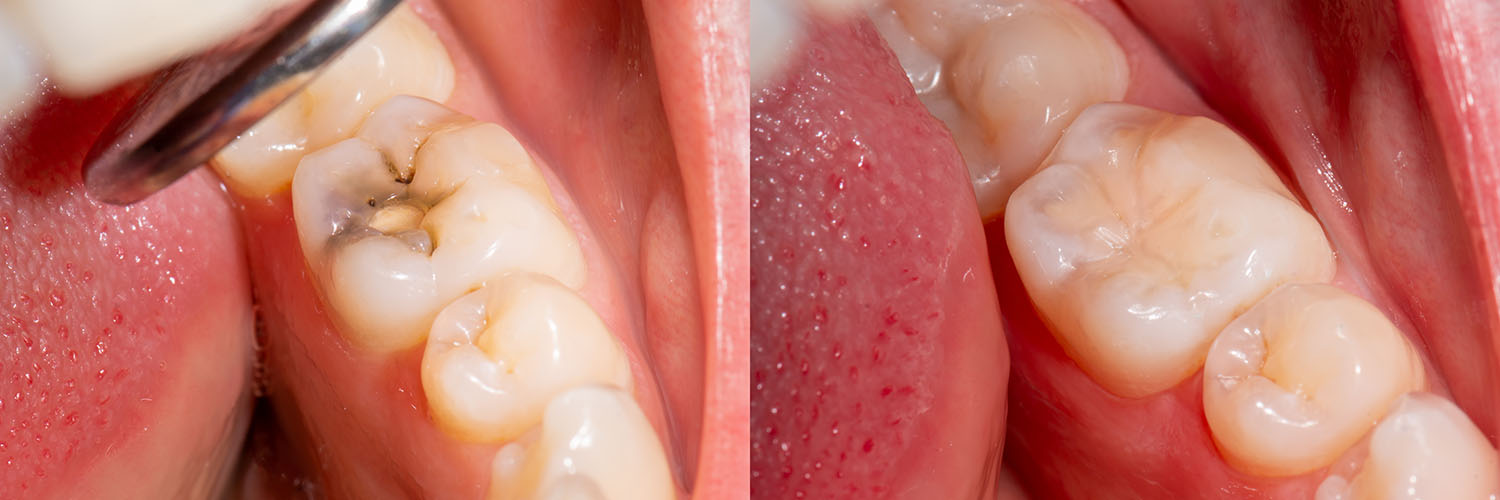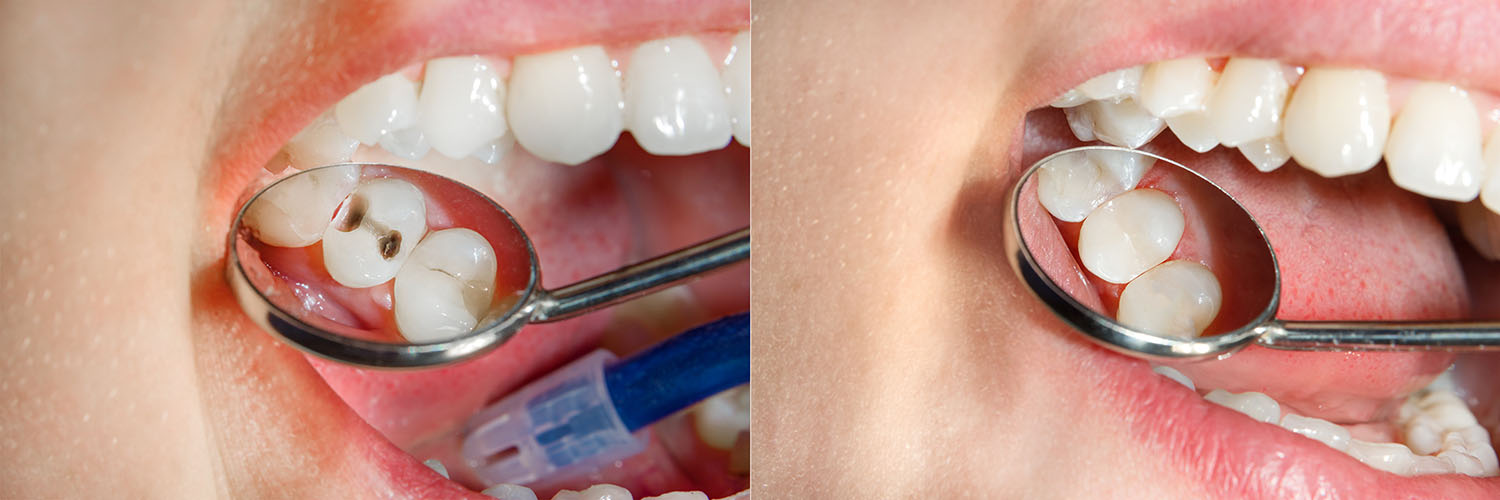Call Us Today!
(248) 863-9109
New Patients
(248) 221-2314

When a tooth develops decay or sustains damage, a filling restores the surface so that you can chew, speak, and smile without discomfort. Fillings stop the progression of decay, rebuild weakened enamel, and return a tooth to a functional shape. For many patients, a timely restoration prevents the need for more extensive treatment later.
Dental caries remains a very common health concern across all ages. That prevalence makes restorative care — including fillings — a routine but essential part of general dentistry. A well-placed restoration protects the tooth from further breakdown and supports long-term oral health.
Patients appreciate restorations that are both durable and discreet. Modern materials and placement techniques focus on conserving healthy tooth structure while producing outcomes that look natural. At the office of Royal Dental Center, we emphasize careful diagnosis and conservative repairs so each restoration preserves as much of the natural tooth as possible.
A filling's role is simple: remove diseased or damaged tissue, then replace it with a material that restores shape and protects the underlying tooth. This process reduces sensitivity, restores chewing surfaces, and seals the area against bacteria. The goal is function first, followed by aesthetics.
Advances in adhesive dentistry have changed how dentists approach restorations. Instead of relying solely on mechanical retention, many modern materials bond to tooth structure, allowing smaller, more conservative preparations and stronger long-term results.
Your dentist will evaluate the size, location, and remaining tooth structure to recommend the most appropriate restorative approach. That recommendation factors in durability, appearance, and the expected stresses on the tooth during everyday use.

Dental restoratives have evolved from crude early repairs into a wide array of refined materials engineered for strength and biocompatibility. Historic solutions prioritized durability, but today there is greater emphasis on materials that mimic the optical and mechanical properties of natural teeth.
Modern restoratives fall into two broad categories: direct restorations placed immediately in the mouth and indirect restorations fabricated outside the mouth and cemented or bonded into place. Each approach has advantages depending on the extent of decay and the functional demands placed on the tooth.
Material science has produced options that are metal-free, mercury-free, and highly aesthetic while still offering reliable performance. This broad selection allows clinicians to tailor treatment to each patient’s priorities — whether that's the longest possible lifespan, the best cosmetic match, or a balance of both.
We believe in recommending restorations that align with the patient’s clinical needs and cosmetic goals. That means explaining the pros and cons of each option and choosing the most conservative solution that will last. When appropriate, we favor adhesive, tooth-conserving techniques that reduce the need for future restorative cycles.
Good technique and proper isolation during placement are as important as the material choice itself. A carefully placed filling with meticulous attention to bonding and contour will resist wear, reduce leakage, and deliver predictable results over time.
While every case differs, patients benefit from a clear plan: diagnose, remove decay, restore the form and function, and monitor over time to protect the investment in oral health.
Selecting a filling material involves weighing strength, appearance, longevity, and how much tooth structure must be removed to place the restoration. Smaller cavities are often ideal for direct restorations, while larger or heavily restored teeth may require indirect solutions such as inlays or onlays.
Another important consideration is the location of the tooth. Back teeth experience the highest chewing forces, so durability is a key factor there. Front teeth prioritize aesthetics, so color-matching and translucency play larger roles in material selection.
Your dentist will discuss these factors with you and recommend the material that best fits the clinical picture and your preferences. We keep the conversation practical and straightforward so patients can make informed choices about their care.
Composite restorations are made from a resin matrix combined with finely ground filler particles. They are available in a range of shades to blend with natural teeth and can be placed directly in one visit. Because composites bond to the tooth, they often require less removal of healthy tooth structure and can support conservative repairs.
Composites work well for visible areas and small to medium-sized cavities. While very versatile and aesthetic, they can be more susceptible to wear and staining over long periods and may require replacement eventually.
Amalgam is a long-standing restorative option known for strength and wear resistance. It performs well in high‑stress areas and is less technique-sensitive during placement. Although not tooth‑colored, amalgam remains a durable choice for certain posterior restorations.
Glass ionomers chemically bond to tooth structure and gradually release fluoride, which can help protect the surrounding enamel. They are often chosen for pediatric dentistry, restorations near the gumline, or as interim solutions while definitive treatment is planned.
Ceramic restorations are crafted outside the mouth and then bonded to the prepared tooth. They offer excellent longevity, stain resistance, and a very natural appearance, making them suitable for larger restorations where aesthetics and strength are both priorities.
Gold restorations are less common today but still valued for their durability and biocompatibility. When chosen, they provide a predictable, long‑lasting solution, particularly for patients who prioritize longevity and function.

A typical filling appointment begins with a careful exam and diagnostic imaging if needed. Your dentist will explain the findings and outline the steps to remove decay and restore the tooth. Most routine restorations are completed in a single visit.
Local anesthesia is commonly used to ensure comfort throughout the procedure. Once the area is numb, the decayed tissue is removed using a handpiece, laser, or air abrasion depending on the situation and clinician preference. The tooth is then prepared and, if necessary, isolated to keep the field dry for bonding.
The placement technique depends on the material selected. Direct restorations like composite are placed incrementally and cured, while indirect options require impressions or digital scans and a follow-up visit for final cementation. After placement, the restoration is shaped and polished, and your bite is checked and adjusted for comfort.
For patients who experience dental anxiety, the dental team will discuss comfort options before beginning treatment. The goal is to provide a calm, respectful experience and to ensure the patient understands each step as care proceeds.
Following placement, a newly restored tooth may feel slightly different as your mouth adjusts. Temporary sensitivity to hot, cold, or pressure is common and typically resolves within days to a few weeks. If sensitivity increases or persistent discomfort develops, contact the practice for an evaluation.
While local anesthesia lasts, avoid chewing on the numb area to prevent biting soft tissues. Once normal sensation returns, resume normal brushing and flossing. Routine oral hygiene and regular dental checkups are the best ways to prolong the life of any restoration.
Restorations are subject to normal wear and may need repair or replacement over time. Avoiding habits like chewing ice or using teeth as tools, and addressing bruxism or grinding when present, helps extend the lifespan of fillings.
At the office of Royal Dental Center, we provide clear post‑treatment instructions and schedule follow-up care as needed. If you have questions about comfort, function, or maintenance of your restoration, our team is available to guide you.

If you would like more information about dental fillings or to discuss which restorative option is best for your smile, please contact us for additional details and to schedule an appointment.
If the pleasure of eating a delicious bowl of ice cream or sipping a soothing cup of tea gets overshadowed by dental pain that makes you wince; it's time to contact our office. As skilled providers of care, we'll determine what's causing your discomfort and perform the treatment required to alleviate your symptoms and get you back on the road to oral health.
Cavities develop because of an infectious process that causes progressive damage to tooth structure. Despite starting as a pinpoint defect on the outermost enamel layer of your tooth, untreated dental decay progressively compromises more and more healthy tooth structure as it works its way to the inner layers of your tooth.
Yes, you can still develop tooth decay on other surfaces of the tooth, around the margins of an old filling, or in fewer instances, recurrent decay underneath it. For this reason, it's essential to maintain excellent oral hygiene, a diet low in sugary beverages and sweets, and be sure to visit our office for routine checkups and care. While tooth decay is second only to the common cold in frequency, it's almost entirely preventable.
We value the time and comfort of our patients. If cavities are located on adjacent teeth, or in the same section of your smile, it may be possible to treat more than one tooth during your visit. However, how much is done each visit depends on several factors. We keep our patients well informed and tailor every treatment plan and visit to address their unique needs.
Addressing concerns on the presence of elemental mercury in silver fillings, the American Dental Association (ADA), The Center for Disease Control and Prevention (CDC), the FDA, and the World Health Organization have all stated that amalgam restorations do not pose a risk to health. However, individuals with allergies or sensitivities to the metals in dental amalgam are advised to pursue other restorative options.
Dental fillings are performed under local anesthesia to help ensure your comfort throughout the entire procedure. The involved tooth remains completely numb for the extent of your visit. Within one or two hours after the procedure is completed, the local anesthetic will gradually wear off, and normal sensations return.
A tooth-colored composite filling is fully hardened and set by the end of your visit. However, we may advise you to wait a couple of hours until the local anesthesia has completely worn off. This advice is to help ensure you don't accidentally bite your lip, cheek, or tongue while still numb.
The lifetime of a dental filling varies depending on the type of material used. While popular dental materials can last a decade or more with proper care, they can degrade over time, wear down, or even break. When this happens, you may experience some tooth sensitivity, a jagged edge, or a loose or dislodged piece of filling material. Whatever the case may be, it's essential to get the filling replaced before the tooth sustains further damage or other consequences arise. Beyond taking good care of your smile to help ensure the longevity of your fillings, our office regularly checks the status of your existing fillings as part of a routine checkup exam.
Dental fillings are an essential investment that serves to preserve and protect the health of your smile. With that said, how much a filling costs depends on the number of surfaces of the tooth involved and the filling material that is used. Amalgam restorations are the most economical. While tooth-colored composite fillings have a slightly higher cost, they offer the added benefits of being metal-free and much more aesthetically pleasing. Ceramic fillings, inlays, and onlays are more expensive than the preceding options but provide outstanding, long-lasting, and natural-looking results.
Dental insurances typically cover the cost of dental fillings. While we work with you to maximize your insurance benefits, there may still be an out-of-pocket expense. At the office of Royal Dental Center, we strive to help you begin care without any additional financial stress or delay.
Dental fillings are restorative materials used to repair teeth damaged by decay or minor fractures and to restore healthy form and function. They replace lost tooth structure after diseased tissue is removed and help prevent further deterioration of the tooth. Fillings also restore proper chewing function and protect the pulp—the inner living portion of the tooth—from bacteria.
Depending on the extent of damage and the location of the tooth, fillings can be placed as a conservative alternative to more extensive restorations. Modern materials allow dentists to match a filling to the natural color of the tooth, improving both function and appearance. Your dentist will recommend the most appropriate material and technique for your specific situation.
Several filling materials are commonly used, including composite resins (tooth-colored fillings), dental amalgam (silver-colored fillings), glass ionomer cements, ceramic inlays and onlays, and gold restorations. Composite resins and ceramics are popular for their aesthetic qualities, while amalgam and gold are recognized for long-term durability in demanding biting areas. Glass ionomer cements bond chemically to tooth structure and release fluoride, which can help protect vulnerable teeth.
Each material has strengths and limitations related to durability, appearance, wear resistance, and suitability for specific tooth locations. Your dentist will weigh those factors along with the amount of remaining healthy tooth structure when recommending a material. In many cases, aesthetic, functional, and longevity considerations are balanced to select the best option for the patient.
Treatment begins with a thorough exam, often including visual inspection and dental X-rays to determine the size and depth of decay. The tooth is then prepared by gently removing decayed tissue and shaping the cavity to receive the chosen restorative material, typically under local anesthesia so the procedure is comfortable. Depending on the tools and technology available, removal may be performed with a dental drill, laser, or air abrasion device.
After preparation, the filling material is placed and shaped to restore the tooth's contours and bite. Direct materials such as composite and glass ionomer are placed and cured in the mouth during the same appointment, while indirect restorations like ceramic inlays are fabricated in a dental lab and bonded in a follow-up visit. The entire visit usually takes about an hour for a routine filling, though times vary with complexity.
It is common to experience numbness in the treated area for an hour or two after anesthesia; during this time you should avoid chewing or consuming hot beverages to prevent accidental injury. The restored tooth may feel slightly different for a short period as your mouth adjusts to the new shape, and minor bite adjustments may be completed at a follow-up if needed. Your dentist will check the occlusion and polish the restoration to ensure proper comfort and function.
Short-term sensitivity to cold, hot, or sweet stimuli is normal and typically resolves within days to a few weeks as the tooth adapts. If you experience increasing pain, prolonged sensitivity, swelling, or an unusual reaction, contact the office promptly for evaluation. Timely follow-up helps identify issues such as high bite, incomplete removal of decay, or the need for additional treatment.
Longevity of a filling depends on the material used, the size and location of the restoration, oral hygiene habits, and the patient’s bite and diet. Composite and glass ionomer fillings commonly last several years, while gold and ceramic restorations can last significantly longer when well cared for. Regular dental exams and X-rays help monitor restorations for wear, marginal breakdown, recurrent decay, or cracks.
A filling may need replacement when it shows signs of leakage, recurrent decay at the margins, a visible fracture, or if it causes persistent sensitivity or discomfort. Rather than waiting for a failure, routine checkups allow your dentist to identify early changes and address them conservatively when possible. Proactive care and good oral hygiene extend the life of restorations.
Both amalgam and composite fillings have a long history of clinical use and are considered appropriate options depending on individual needs and clinical circumstances. Amalgam is a durable alloy that includes mercury as part of the material, and major health organizations have concluded that amalgam is safe for most patients when placed and removed using recommended protocols. Composite resins are mercury-free and provide excellent esthetics, bonding to tooth structure to preserve more natural tooth when possible.
At Royal Dental Center, we discuss the benefits and considerations of each material so patients can make informed choices based on health history, tooth location, and cosmetic priorities. If you have specific health concerns or preferences, your dentist will tailor recommendations and follow safety protocols for placement and, if necessary, safe removal. Alternatives such as ceramic or gold restorations are also available for patients who prefer them.
Minor chipping or localized wear can sometimes be repaired with additional composite material, especially when the existing restoration is otherwise sound. Conservative repair preserves as much healthy tooth structure as possible and can extend the life of the restoration without full replacement. The feasibility of repair depends on the material, the extent of damage, and the condition of the surrounding tooth.
If the damage is extensive, the restoration may need to be replaced or upgraded to a larger indirect restoration such as an inlay, onlay, or crown to restore strength and function. Prompt evaluation by your dentist is important because small problems can progress and compromise the tooth if left untreated. Regular dental visits allow early detection and minimally invasive management of restoration problems.
Short-term sensitivity after a filling is common and often relates to the preparation and the tooth's response to the restoration process; this typically diminishes over days to weeks. Sensitivity can be triggered by temperature changes, sweet foods, or biting pressure and may reflect the tooth settling after treatment. Good technique and appropriate material selection help minimize long-term sensitivity.
Persistent or worsening pain may indicate issues such as a high bite, incomplete removal of decay, leakage around the restoration, or pulpal inflammation that requires further care. If sensitivity does not improve or is accompanied by swelling or severe pain, contact the dental office for an assessment so that any necessary treatment can be provided. Early evaluation helps prevent more extensive procedures.
Composite fillings bond directly to tooth structure and provide excellent esthetics, but they can be more susceptible to staining and wear over time than ceramics or gold. Avoiding highly staining foods and beverages, limiting tobacco use, and maintaining consistent oral hygiene reduces the risk of discoloration and surface degradation. Regular professional cleanings and exams help preserve the appearance and function of composite restorations.
Because composites rely on a strong bond to the tooth, placement technique is important for durability and to minimize sensitivity. In cases of large cavities, an indirect restoration such as a ceramic inlay or onlay may offer improved longevity and resistance to wear. Discussing expectations and maintenance with your dentist will help you choose the right material for your needs.
Yes, fillings are a common and effective way to treat cavities in children and to protect primary teeth until they are naturally lost. Glass ionomer materials are frequently used in pediatric dentistry because they bond well, release fluoride, and can be a conservative option for small to moderate cavities near the gumline. Composite resins are also used when a tooth-colored restoration and stronger wear resistance are desired.
Timely treatment of cavities in baby teeth helps prevent pain, infection, and premature loss that can affect chewing and the eruption of permanent teeth. Preventive measures such as fluoride applications, dental sealants, and routine cleanings complement restorative care and reduce future treatment needs. Pediatric treatment plans are tailored to the child’s development, cooperation level, and specific oral health needs.
Take the first step toward exceptional dental care! Schedule your appointment with Royal Dental Center today and experience personalized treatment, advanced technology, and a caring team dedicated to your comfort and oral health. Don’t wait—your best smile starts now.
